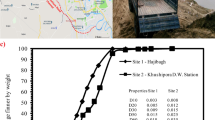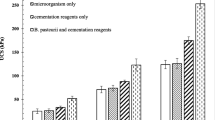Abstract
During the past few years, microbial geotechnology has gained a lot of attention from researchers as it is an eco-friendly method of soil improvement causing no impairment to the soil and groundwater. In this study, a bacillus species, B. subtilis has been used to enhance the unconfined compressive strength and the penetration resistance of weak dredged soil obtained from ‘Hokersar Wetlands’ in Bemina area of Srinagar. The microbes were added at different optical densities (0.4, 1.0 and 1.3) and treated with a cementing solution of urea and calcium chloride at different molarities (0.25 M, 0.5 M, 1.0 M) for 48 h. Testing was done in a temperature-controlled chamber (25–28 °C) maintaining a pH of 7–9 and the samples were cured for 7, 14 and 28 days, respectively. It is observed that with increasing optical density and molarity of cementing solution, there is an increase in calcium carbonate precipitation which in turn increases the unconfined compressive strength and the penetration resistance of the soil. The increase in strength from 197 to 537 kN/m2 was appreciable, the un-soaked California bearing ratio increased from 5.6 to 11.5%, whereas the soaked California bearing ratio increased from 1.3 to 7%. The results were in turn supported by scanning electron microscopy and X-ray diffraction technique. Treated dredged soil can be utilized in bulk, as a resource for various engineering applications for eco-friendly and sustainable development of environment.












Similar content being viewed by others
Change history
09 March 2020
The complete source details regarding permission for reproducing the images were missing in the original publication and are included in this erratum. In the original publication, Figs. 2, 3, 4, 5, 11a–d, were reprinted from the paper ‘Influence of Microbial Geo-technology in the Stabilization of Dredged Soils’ by K. M. N. Saquib Wani and B. A. Mir, International Journal of Geotechnical Engineering, pp. 1–10, https://doi.org/10.1080/19386362.2019.1643099 by permission of the publisher (Taylor & Francis Ltd, http://www.tandfonline.com). This was done by the authors in view of the continuity of their PhD research progress on a specific site location for a set of experimental variables and parameters.
References
Ho MH, Chan CM (2011) Some mechanical properties of cement stabilized Malaysian soft clay. World Acad Sci Eng Technol 74:24–31
Huat BB (2006) Deformation and shear strength characteristics of some tropical peat and organic soils. Pertanika J Sci Technol 14(1–2):61–74
Kazemian S, Prasad A, Huat BB, Barghchi M (2011) A state of art review of peat: geotechnical engineering perspective. Int J Phys Sci 6(8):1974–1981
Mir BA, Shah BM, Shah FA (2017) Some model studies on reinforced dredged soil for sustainable environment. Euro-mediterranean conference for environmental integration. Springer, Cham, pp 1697–1700
Mir BA, Amin F, Majid B (2016) Some studies on physical and mechanical behaviour of dredged soil from flood spill channel of Jhelum river Srinagar. Acta Ingenier Aa Civil. https://doi.org/10.20936/AICV/160101
Mir BA (2017) Some studies on mechanical behaviour of cement stabilized dredged soil from flood spill channel of Jhelum River Srinagar. International congress and exhibition, sustainable civil infrastructures: innovative infrastructure geotechnology. Springer, Cham, pp 386–406
Kazemian S, Huat BB (2009) Assessment and comparison of grouting and injection methods in geotechnical engineering. Eur J Sci Res 27(2):234–247
Anagnostopoulos C, Hadjispyrou S (2004) Laboratory study of an epoxy resin grouted sand. Proc Inst Civil Eng Gr Improv 8(1):39–45
Basha EA, Hashim R, Mahmud HB, Muntohar AS (2005) Stabilization of residual soil with rice husk ash and cement. Constr Build Mater 19(6):448–453
Karol RH (2003) Chemical grouting and soil stabilization, revised and expanded. CRC Press, Boca Raton
Peethamparan S, Olek J, Diamond S (2009) Mechanism of stabilization of Na-montmorillonite clay with cement kiln dust. Cem Concr Res 39(7):580–589
Xanthakos PP, Lee WA, Donald AB (1994) Jet grouting-chapter (8). Ground control and improvement, 1st edn. Wiley, Hoboken, pp 580–592
DeJong JT, Fritzges MB, Nusslein K (2006) Microbially induced cementation to control sand response to undrained shear. J Geotech Geoenviron Eng 132(11):1381–1392
DeJong JT, Mortensen BM, Martinez BC, Nelson DC (2010) Bio-mediated soil improvement. Ecol Eng 36(2):197–210
Baveye P, Vandevivere P, Hoyle BL, DeLeo PC, de Lozada DS (1998) Environmental impact and mechanisms of the biological clogging of saturated soils and aquifer materials. Crit Rev Environ Sci Technol 28(2):123–191
Ehrlich HL (1998) Geomicrobiology: its significance for geology. Earth Sci Rev 45(1–2):45–60
Mitchell JK, Santamarina JC (2005) Biological considerations in geotechnical engineering. J Geotech Geoenviron Eng 131(10):1222–1233
Lian B, Hu Q, Chen J, Ji J, Teng HH (2006) Carbonate biomineralization induced by soil bacterium Bacillus megaterium. Geochimica et Cosmochim Acta 70(22):5522–5535
Ivanov V, Chu J (2008) Applications of microorganisms to geotechnical engineering for bioclogging and biocementation of soil in situ. Rev Environ Sci Bio/Technol 7(2):139–153
Okwadha GD, Li J (2010) Optimum conditions for microbial carbonate precipitation chemosphere 81(9):1143–1148
Harkes MP, Van Paassen LA, Booster JL, Whiffin VS, Van Loosdrecht MC (2010) Fixation and distribution of bacterial activity in sand to induce carbonate precipitation for ground reinforcement. Ecol Eng 36(2):112–117
Lu W, Qian C, Wang R (2010) Study on soil solidification based on microbiological precipitation of CaCO3. Sci China Technol Sci 53(9):2372–2377
Baskar S, Baskar R, Mauclaire L, McKenzie JA (2006) Microbially induced calcite precipitation in culture experiments: possible origin for stalactites in Sahastradhara caves, Dehradun, India. Curr Sci 90(1):58–64
Chu J, Ivanov V, Naeimi M, Stabnikov V, Liu HL (2014) Optimization of calcium-based bioclogging and biocementation of sand. Acta Geotech 9(2):277–285
Hammes F, Boon N, De Villiers J, Verstraete W, Siciliano SD (2003) Strain-specific ureolytic microbial calcium carbonate precipitation. Appl Environ Microbiol 69(8):4901–4909
Ng WS, Lee ML, Hii SL (2012) An overview of the factors affecting microbial-induced calcite precipitation and its potential application in soil improvement. World Acad Sci Eng Technol 62:723–729
Mujah D, Shahin MA, Cheng L (2017) State-of-the-art review of biocementation by microbially induced calcite precipitation (MICP) for soil stabilization. Geomicrobiol J 34(6):524–537
Wang Z, Zhang N, Cai G, Jin Y, Ding N, Shen D (2017) Review of ground improvement using microbial induced carbonate precipitation (MICP). Mar Georesour Geotechnol 35(8):1135–1146
Cheng L, Shahin MA, Mujah D (2016) Influence of key environmental conditions on microbially induced cementation for soil stabilization. J Geotech Geoenviron Eng 143(1):04016083
Soon NW, Lee LM, Khun TC, Ling HS (2014) Factors affecting improvement in engineering properties of residual soil through microbial-induced calcite precipitation. J Geotechn Geoenviron Eng 140(5):04014006
Umar M, Kassim KA, Chiet KTP (2016) Biological process of soil improvement in civil engineering: a review. J Rock Mech Geotech Eng 8(5):767–774
Achal V, Pan X (2014) Influence of calcium sources on microbially induced calcium carbonate precipitation by Bacillus sp. CR2. Appl Biochem Biotechnol 173(1):307–317
Shahrokhi-Shahraki R, Zomorodian SMA, Niazi A, O’Kelly BC (2015) Improving sand with microbial-induced carbonate precipitation. Proc Inst Civil Eng Gr Improv 168(3):217–230
Cheng L, Shahin MA, Cord-Ruwisch R, Addis M, Hartanto T, Elms C (2014) Soil stabilisation by microbial-induced calcite precipitation (MICP) Investigation into some physical and environmental aspects. In: 7th International Congress on Environmental Geotechnics: ICEG 2014 Engineers Australia, pp 1105
Stocks-Fischer S, Galinat JK, Bang SS (1999) Microbiological precipitation of CaCO3. Soil Biol Biochem 31(11):1563–1571
Evans DJ, Evans DG, Takemura T, Nakano H, Lampert HC, Graham DY, Kvietys PR (1995) Characterization of a Helicobacter pylori neutrophil-activating protein. Infect Immun 63(6):2213–2220
Arunachalam KD, Sathyanarayanan KS, Darshan BS, Raja RB (2010) Studies on the characterisation of biosealant properties of Bacillus sphaericus. Int J Eng Sci Technol 2(3):270–277
Mobley HL, Island MD, Hausinger RP (1995) Molecular biology of microbial ureases. Microbiol Mol Biol Rev 59(3):451–480
Akiyama M, Kawasaki S (2012) Microbially mediated sand solidification using calcium phosphate compounds. Eng Geol 137:29–39
Ahmed F, Yahaya A, Farooki M (2006) Characterization and geotechnical properties of Penang residual soils with emphasis on landslides. Am J Environ Sci 2(4):121–128
Steinberg D, Gockel J, Wagner N, Ostmann K (2016) How to Bacillus subtilis? B. subtilis manual, A collaboration Bonn–Freiburg, IGEM Team pp 1–13
Ramachandran SK, Ramakrishnan V, Bang SS (2001) Remediation of concrete using micro-organisms. ACI Mater J Am Concr Inst 98(1):3–9
ASTM D2216–10 (2010) Standard test methods for laboratory determination of water (moisture) content of soil and rock by mass. ASTM International, West Conshohocken. https://doi.org/10.1520/D2216-10
ASTM D6913, D6913 M-17 (2017) Standard test methods for particle-size distribution (Gradation) of soils using sieve analysis. ASTM International, West Conshohocken. https://doi.org/10.1520/D6913_D6913M-17
ASTM D854–14 (2014) Standard test methods for specific gravity of soil solids by water pycnometer. ASTM International, West Conshohocken. https://doi.org/10.1520/D0854-14
ASTM D4318–17e1 (2017) Standard test methods for liquid limit, plastic limit, and plasticity index of soils. ASTM International, West Conshohocken. https://doi.org/10.1520/D4318-17E01
ASTM D698–12e2 (2012) Standard test methods for laboratory compaction characteristics of soil using standard effort (12 400 ft-lbf/ft3 (600 kN-m/m3)). ASTM International, West Conshohocken. https://doi.org/10.1520/D0698-12E02
Umar M, Kassim KA, Chiet KTP (2016) Temperature effects on the strength properties of microbially stabilized residual soil. JurnalTeknologi 78:7–13
ASTM D2166, D2166 M-16 (2016) Standard test method for unconfined compressive strength of cohesive soil. ASTM International, West Conshohocken. https://doi.org/10.1520/D2166_D2166M-16
Ta HX (2016) Microbial bio-film in porous sediments: effects on soil behaviour
ASTM D1883-16 (2016) Standard test method for california bearing ratio (CBR) of laboratory-compacted soils. ASTM International, West Conshohocken. http://www.astm.org/cgi-bin/resolver.cgi?D1883
Chen KB, Bin Kassim KA (2015) Microbial induced cementation on tropical residual soil
Jan OQ, Mir BA (2018) Strength behaviour of cement stabilised dredged soil. Int J Geosynth Ground Eng 4(2):16
Jan OQ, Mir BA (2018) Mechanical behavior of cement stabilized dredged soil. Glob J Res Eng
Chou CW, Seagren EA, Aydilek AH, Lai M (2011) Biocalcification of sand through ureolysis. J Geotech Geoenviron Eng 137(12):1179–1189
Al Qabany A, Soga K, Santamarina C (2011) Factors affecting efficiency of microbially induced calcite precipitation. J Geotech Geoenviron Eng 138(8):992–1001
Zhao Q, Li L, Li C, Li M, Amini F, Zhang H (2014) Factors affecting improvement of engineering properties of MICP-treated soil catalyzed by bacteria and urease. J Mater Civ Eng 26(12):04014094
Wani K M N Saquib, Mir BA (2019) Influence of microbial geo-technology in the stabilization of dredged soils. Int J Geotech Eng. https://doi.org/10.1080/19386362.2019.1643099
Acknowledgements
The experimental work reported in this paper forms a part of research work at National Institute of Technology, Srinagar. Thanks are due to the Institute of Administration and Civil Department for providing the necessary facilities in carrying out this work and Department Of Clinical Biochemistry SKUAST-K, Shalimar, for proper assistance on bacterial culture preparations and for providing laboratory facilities.
Funding
No funding was received for this research but it is to mention here that this research work forms a part of the PhD work for which monthly scholarship is received from MHRD, India.
Author information
Authors and Affiliations
Corresponding author
Ethics declarations
Conflict of interest
On behalf of all authors, the corresponding author states that there is no conflict of interest.
Additional information
Publisher's Note
Springer Nature remains neutral with regard to jurisdictional claims in published maps and institutional affiliations.
Rights and permissions
About this article
Cite this article
Wani, K.M.N., Mir, B.A. Effect of Biological Cementation on the Mechanical Behaviour of Dredged Soils with Emphasis on Micro-structural Analysis. Int. J. of Geosynth. and Ground Eng. 5, 32 (2019). https://doi.org/10.1007/s40891-019-0183-9
Received:
Accepted:
Published:
DOI: https://doi.org/10.1007/s40891-019-0183-9




